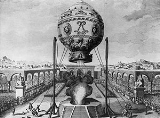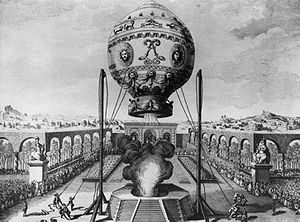
Jean-Baptiste Réveillon
Encyclopedia
Jean-Baptiste Réveillon, (Paris, 1725 – Paris, 1811) was a French wallpaper
manufacturer. Réveillon's career was an exemplary story of the self-made businessman.
and stationer. In 1753 he began to import and hang flock wallpapers from England. The papier bleu d'Angleterre became very popular when Marie Antoinette
, decorated her apartments with them. During the Seven Years War Reveillon starting to produce wallpaper himself, marrying well and using the dowry to produce velvet paper, pasted up into rolls and using fast colours, developed by Jean-Baptiste Pillement
.
 In 1759 he moved to the Faubourg Saint-Antoine, then a neighbourhood dominated by the various crafts associated with furnishing. Réveillon launched production of a full range of wallpapers. The dukes were exited and in 1765—already extremely wealthy—he bought a mansion, with a parc and a theatre inside La Folie Titon, formerly owned by Évrard Titon du Tillet
In 1759 he moved to the Faubourg Saint-Antoine, then a neighbourhood dominated by the various crafts associated with furnishing. Réveillon launched production of a full range of wallpapers. The dukes were exited and in 1765—already extremely wealthy—he bought a mansion, with a parc and a theatre inside La Folie Titon, formerly owned by Évrard Titon du Tillet
. The production of wallpaper was inside.
In 1775 Réveillon opened a paper mill to improve both the quantity and quality of his paper supply. In 1776 he opened a shop near the Tuileries. Ambassador and kings came to visit and buy from him. Réveillon himself dabbled chemistry enough to discover a new process for making vellum
paper in 1782. The following year he was granted permission to use the title of Manufacture Royale.
His purchase of the paper mill and expertise in paper production brought him into contact with Etienne de Montgolfier, and it was from Réveillon’s garden at Folie Titon that the first hot-air balloon was launched on 12 September 1783. Réveillon delivered a special and colourful wallpaper, used cover up the balloon. A second balloon, called Le Réveillon, with a rooster, a duck and a sheep was launched a week later at Versailles
. On 19 October his employee André Giroud de Villette and Jean-François Pilâtre de Rozier went into the sky, as pioneers of ballooning, but it was not a free flight.
"In the year 1789 Réveillon was the casualty of his own ill-digested reflections on modern economics. 'Since bread was the foundation of our national economy' its distribution should be deregulated, permitting lower prices. That in turn would allow lower wage costs, lower manufacturing prices and brisk consumption." On 28 April 1789 his mansion was destroyed, all the wallpaper, glue, furniture and paintings were burned, except 2,000 bottles of wine. Réveillon and his family escaped by climbing a wall and fled to the Bastille
, with the help of his friend Jacques Necker
. It was a bloody day, some say 25 other believe 900 people died. The rioters were savagely repressed, in an opening episode of the French Revolution
. Today plaques mark the site of the Reveillon riot
.
Réveillon moved to England and rented out his manufacture to Jacquemart & Bénard, who produced wallpaper till 1840.
Wallpaper
Wallpaper is a kind of material used to cover and decorate the interior walls of homes, offices, and other buildings; it is one aspect of interior decoration. It is usually sold in rolls and is put onto a wall using wallpaper paste...
manufacturer. Réveillon's career was an exemplary story of the self-made businessman.
Life
Réveillon apprenticed as a tradesman, haberdasherHaberdasher
A haberdasher is a person who sells small articles for sewing, such as buttons, ribbons, zips, and other notions. In American English, haberdasher is another term for a men's outfitter. A haberdasher's shop or the items sold therein are called haberdashery.-Origin and use:The word appears in...
and stationer. In 1753 he began to import and hang flock wallpapers from England. The papier bleu d'Angleterre became very popular when Marie Antoinette
Marie Antoinette
Marie Antoinette ; 2 November 1755 – 16 October 1793) was an Archduchess of Austria and the Queen of France and of Navarre. She was the fifteenth and penultimate child of Holy Roman Empress Maria Theresa and Holy Roman Emperor Francis I....
, decorated her apartments with them. During the Seven Years War Reveillon starting to produce wallpaper himself, marrying well and using the dowry to produce velvet paper, pasted up into rolls and using fast colours, developed by Jean-Baptiste Pillement
Jean-Baptiste Pillement
Jean-Baptiste Pillement was a painter and designer, known for his exquisite and delicate landscapes, but whose importance lies primarily in the engravings done after his drawings, and their influence in spreading the Rococo style and particularly the taste for chinoiserie throughout...
.

Évrard Titon du Tillet
Évrard Titon du Tillet is best known for his important biographical chronicle, Le Parnasse françois, composed of brief anecdotal vite of famous French poets and musicians of his time, under the reign of Louis XIV and the Régence.- Biography :Of Scottish origin, Évrard Titon du Tillet was the son...
. The production of wallpaper was inside.
In 1775 Réveillon opened a paper mill to improve both the quantity and quality of his paper supply. In 1776 he opened a shop near the Tuileries. Ambassador and kings came to visit and buy from him. Réveillon himself dabbled chemistry enough to discover a new process for making vellum
Vellum
Vellum is mammal skin prepared for writing or printing on, to produce single pages, scrolls, codices or books. It is generally smooth and durable, although there are great variations depending on preparation, the quality of the skin and the type of animal used...
paper in 1782. The following year he was granted permission to use the title of Manufacture Royale.
His purchase of the paper mill and expertise in paper production brought him into contact with Etienne de Montgolfier, and it was from Réveillon’s garden at Folie Titon that the first hot-air balloon was launched on 12 September 1783. Réveillon delivered a special and colourful wallpaper, used cover up the balloon. A second balloon, called Le Réveillon, with a rooster, a duck and a sheep was launched a week later at Versailles
Versailles
Versailles , a city renowned for its château, the Palace of Versailles, was the de facto capital of the kingdom of France for over a century, from 1682 to 1789. It is now a wealthy suburb of Paris and remains an important administrative and judicial centre...
. On 19 October his employee André Giroud de Villette and Jean-François Pilâtre de Rozier went into the sky, as pioneers of ballooning, but it was not a free flight.
"In the year 1789 Réveillon was the casualty of his own ill-digested reflections on modern economics. 'Since bread was the foundation of our national economy' its distribution should be deregulated, permitting lower prices. That in turn would allow lower wage costs, lower manufacturing prices and brisk consumption." On 28 April 1789 his mansion was destroyed, all the wallpaper, glue, furniture and paintings were burned, except 2,000 bottles of wine. Réveillon and his family escaped by climbing a wall and fled to the Bastille
Bastille
The Bastille was a fortress in Paris, known formally as the Bastille Saint-Antoine. It played an important role in the internal conflicts of France and for most of its history was used as a state prison by the kings of France. The Bastille was built in response to the English threat to the city of...
, with the help of his friend Jacques Necker
Jacques Necker
Jacques Necker was a French statesman of Swiss birth and finance minister of Louis XVI, a post he held in the lead-up to the French Revolution in 1789.-Early life:...
. It was a bloody day, some say 25 other believe 900 people died. The rioters were savagely repressed, in an opening episode of the French Revolution
French Revolution
The French Revolution , sometimes distinguished as the 'Great French Revolution' , was a period of radical social and political upheaval in France and Europe. The absolute monarchy that had ruled France for centuries collapsed in three years...
. Today plaques mark the site of the Reveillon riot
Reveillon riot
The Réveillon Riot occurred on 28 April 1789 in the St. Antoine district of Paris where a factory which produced luxury wallpaper was owned by Jean-Baptiste Réveillon. The factory employed around 300 people. The Réveillon Riot was one of the first instances of violence during the French Revolution...
.
Réveillon moved to England and rented out his manufacture to Jacquemart & Bénard, who produced wallpaper till 1840.
External links
- http://www.museum-kassel.de/index_navi.php?parent=1600An example of Réveillon's Neo-Classic wallpaper in KasselKasselKassel is a town located on the Fulda River in northern Hesse, Germany. It is the administrative seat of the Kassel Regierungsbezirk and the Kreis of the same name and has approximately 195,000 inhabitants.- History :...
] - http://www.artnet.com/library/07/0716/T071654.asp
- http://cerig.efpg.inpg.fr/histoire-metiers/nicolas-robert/page02.htm

